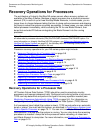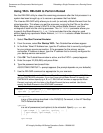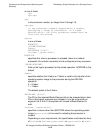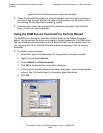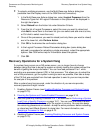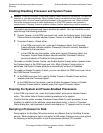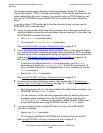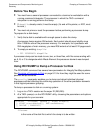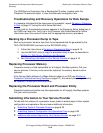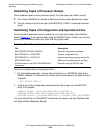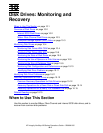
Processors and Components: Monitoring and
Recovery
HP Integrity NonStop NS-Series Operations Guide—529869-005
9-16
Dumping a Processor to Disk
For automatic dumping and reloading of halted processors, use the HP Tandem
Failure Data System (TFDS). To dump automatically, TFDS must be configured on the
system before the halt occurs. However, you can also bring up TFDS following a halt
and use the TFDSCOM command ANALYZE CPU to obtain information about the
failure.
If you did not have TFDS configured to take the processor dump, you can use the
RCVDUMP utility to take the dump.
•
If your service provider determines that a processor halt is divergence-related, you
might be directed to dump the entire processor before reloading it. In this case, use
the RCVDUMP command, as follows:
°
Use BLADE ALL parameter option.
°
Do not specify ONLINE or PARALLEL parameters.
See Using RCVDUMP to Dump a Processor to Disk on page 9-17.
•
If your service provider determines that a processor halt is not divergence-related,
you might be directed to reload the processor while excluding the PE for one Blade
Element, which is then dumped before being reintegrated. In this case, perform the
reload (see Reloading a Single Processor on a Running Server on page 9-10),
then use the RCVDUMP command as follows:
°
If more than one Blade Element is in the Stopped state, use the BLADE
parameter and specify the bladeId (A, B, or C) of the PE to be dumped. (If
only one Blade Element is in the Stopped state, it is not necessary to use the
BLADE parameter.)
°
Specify the PARALLEL parameter.
See Using RCVDUMP to Dump a Processor to Disk on page 9-17.
•
If a dump is to be taken following a system load, as described in Performing a
System Load From a Specific Processor on page 15-11, options for taking dumps
include:
°
After the processor (0 or 1) has been loaded with a Blade Element omitted, use
RCVDUMP with the PARALLEL option.
°
You can dump any of the remaining processors either by dumping the entire
processor before reloading them (use RCVDUMP without specifying the
ONLINE or PARALLEL options), or reload with a Blade Element omitted, then
dump that Blade Element using RCVDUMP with the PARALLEL option.
•
If you are directed to dump a single PE that is running, use the RCVDUMP
command, as follows:
°
Specify the ONLINE parameter.
°
Do not specify the Blade ID (RCVDUMP will choose the first running PE).
See Using RCVDUMP to Dump a Processor to Disk on page 9-17.




